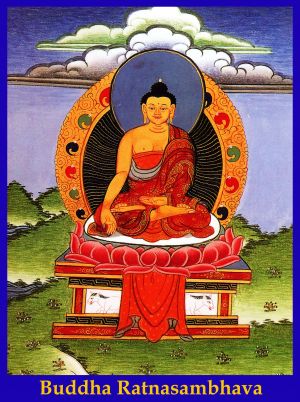Ratnasambhava, Dhyani Buddha
Ratnasambhava (Skt.; Tib. Rinchen Jungné; Tib. རིན་ཆེན་འབྱུང་གནས་ or རིན་ཆེན་འབྱུང་ལྡན་, Wyl. rin chen 'byung gnas, rin chen 'byung ldan; Eng. 'Source of Preciousness') — one of the buddhas of the five families.
He is the Buddha of the ratna family, and is usually depicted as yellow in colour and holding a jewel.
The name Ratnasambhava means “the Jewel-born One” or “Origin of Jewels.”
The Three Jewels are the Buddha, the Dharma and the Sangha.
The Buddha is the Enlightened One, the Guru, the hub of the wheel of the Law. The Dharma is the Teaching, or the Law, and the Sangha is the Community.
Ratnasambhava transmutes the poison of spiritual, intellectual and human pride into the Wisdom of Equality.
Tibetan Buddhists teach that with the Wisdom of Equality one sees all things with divine impartiality and recognizes the divine equality of all beings. One sees all beings and the Buddha as having the same nature. This is a condition we need, says author Giuseppe Tucci, “to spur our spiritual ascension and to acquire the trust to realize in ourselves the status of a Buddha.”1
Ratnasambhava is the Dhyani Buddha of the south. His color is yellow, the color of the sun in its zenith. He rules over the element of earth and embodies the skandha of feeling or sensation.
Ratnasambhava and the Wish-Fulfilling Jewel
Ratnasambhava is sometimes shown holding his symbol, the ratna (jewel) or chintamani (wish-fulfilling jewel that grants all right desires). The chintamani is a symbol of the liberated mind. The ratna is often depicted in a threefold form as the triratna, signifying the union of Buddha, Dharma and Sangha.
The animal that upholds Ratnasambhava's throne is the horse, denoting impetus and liberation.
Ratnasambhava's mudra is the varada mudra. It is the gesture of giving, or charity, which portrays him offering compassion and protection to his disciples. (The right palm faces outward and the fingers are directed downward.)
His bija is Tram and his mantra is Om Ratnasambhava Tram.
mandala of the jinas
position in mandala south
Colour - yellow
Family - Ratna
Mudra - giving
Wisdom - Wisdom of sameness
Emblem - jewel
Consort - prajñā Māmakī
Other- Jinas: Vairocana | Akṣobhya | Amitābha | Amoghasiddhi
Bodhisattvas: Ākāśagarbha
1. Giuseppe Tucci, The Temples of Western Tibet and Their Artistic Symbolism, ed. Lokesh Chandra (New Delhi: Aditya Prakashan, 1988), p. 152.
